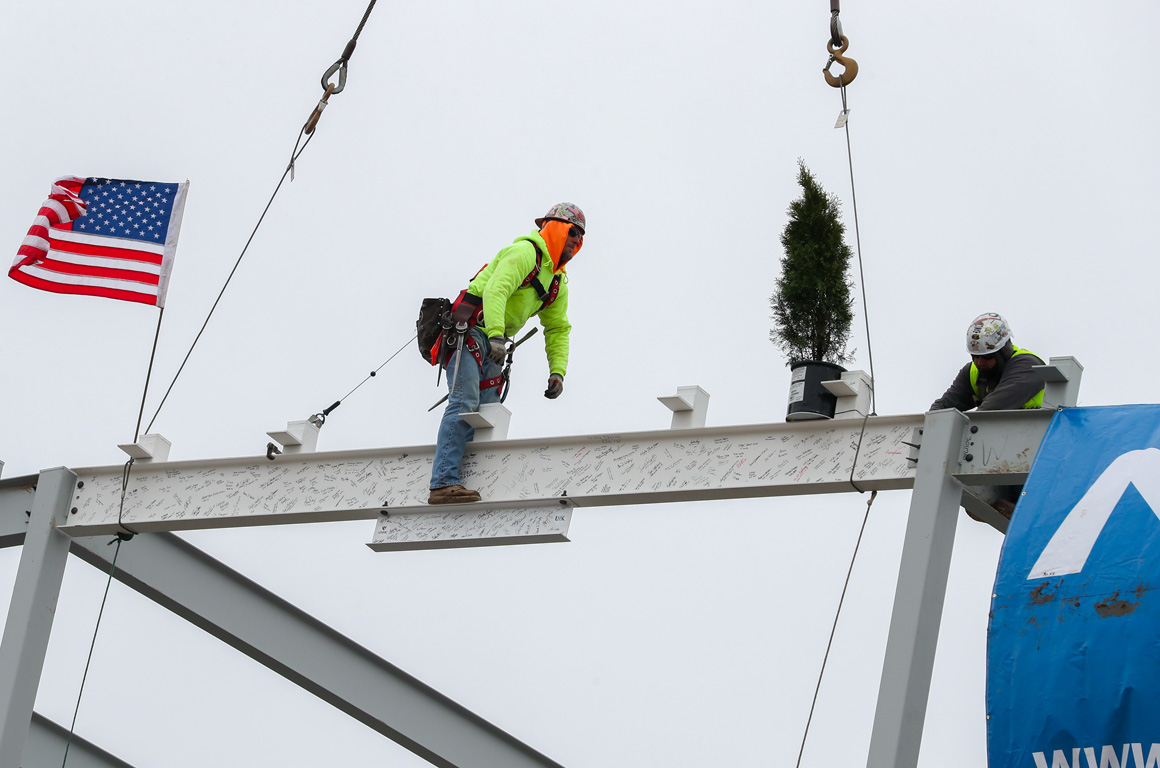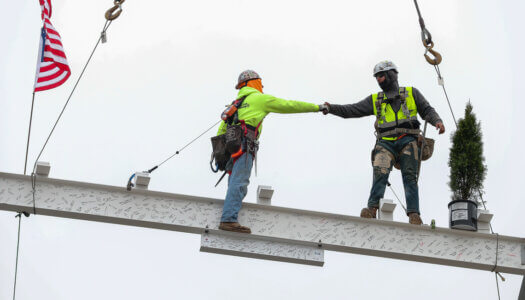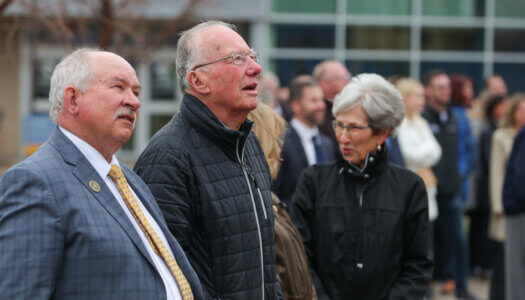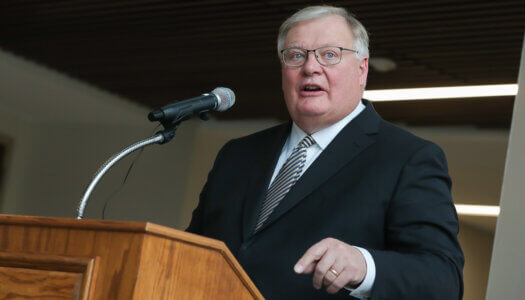
By TYLER ELLYSON
UNK Communications
KEARNEY – The weather was damp and dreary Monday morning – not ideal for a beam-raising ceremony.
But the overcast conditions didn’t bother University of Nebraska Medical Center Chancellor Dr. Jeff Gold. As he looked out at the new Rural Health Education Building under construction on the University of Nebraska at Kearney campus, Gold saw an incredible blue sky and brilliant sunshine, representing the state’s bright future.
“I see a future for health care workforce development in rural Nebraska unlike any other part of the country,” Gold said. “When I look across this sky, I see the results of unique public-private partnerships that frankly could not happen in any other part of the country.”
Before it was lifted into place, marking a major milestone for the $95 million project, the final structural beam was signed by Nebraskans from across the state – students, educators, lawmakers, donors and health care professionals who all share the same vision. They want to preserve the vitality of rural communities and protect the health and well-being of every resident, regardless of where they live.
It takes a family to make a project like this happen, Gold noted, and “the definition of a family is that we take care of each other.”
“We can wring our hands about the challenges that we face in the future, but we’re going to do something proactive about it and we’re going to build that future together,” he said.

More than 125 people attended the beam-raising ceremony, which UNK Chancellor Doug Kristensen called a “historic event” for health care education in Nebraska.
“We really are celebrating more than constructing a building here,” Kristensen said. “I think this is celebrating the strong bond that we have between the University of Nebraska at Kearney and the University of Nebraska Medical Center. This is a partnership that is unlike anything else I’ve seen in state government.”
Because of the weather, Kristensen and Gold spoke inside the Health Science Education Complex, another example of the impactful collaboration between UNK and UNMC. The institutions opened that $19 million facility on UNK’s west campus in 2015 and it quickly filled. Around 300 students are currently pursuing degrees there in professional programs such as cardiovascular interventional technology, diagnostic medical sonography, magnetic resonance imaging, medical laboratory science, nursing, occupational therapy, physical therapy, physician assistant and radiography.
About 85% of the students who graduate from these programs start their careers in rural Nebraska.
That success led to the development of the Rural Health Education Building. Located directly north of the Health Science Education Complex, the Rural Health Education Building further addresses a need for additional health care professionals in rural communities by allowing more students to study and train in central Nebraska.
The three-story, 110,000-square-foot facility will feature state-of-the-art classrooms, cutting-edge technology and extensive simulation and clinical skills laboratories. More importantly, it allows UNMC to expand its allied health and nursing programs in Kearney while launching new programs to train physicians, pharmacists and public health professionals here.
Students will be able to enroll in the newly expanded programs beginning in fall 2025, using existing UNK facilities until the new building opens in early 2026. With a second facility on campus, UNMC will double the number of students it’s training in Kearney, bringing the total to more than 600.

Kristensen believes these two facilities – jointly named the Douglas A. Kristensen Rural Health Education Complex in his honor – represent the future of rural health care education in America. This model, he said, shows other states what’s possible when you bring world-class medical training to the communities that need these professionals the most.
“There is nothing like this, and it’s happening right here,” he said.
The Rural Health Education Building received funding from the Nebraska Legislature, city of Kearney, Central Community College and numerous benefactors, with the William and Ruth Scott Family Foundation serving as the lead donor to the project.
Along with the health care education and training, the facility will enhance clinical research and play a pivotal role in economic development. When fully operational, the Rural Health Education Building and existing Health Science Education Complex will support about 240 local jobs and have an annual economic impact estimated at $34.5 million.
The project also sends a “powerful message” to students who want to live and work in rural communities, according to Gold.
“I can’t help but believe that the investment of the state in these types of programs is pivotal in convincing these young women and young men … to stay here to raise their families and be part of the future and vibrancy of our workforce,” he said.

























